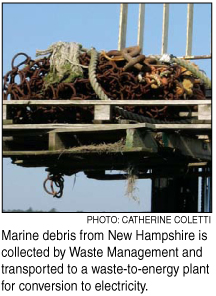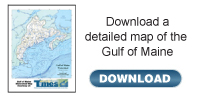
Harnessing the Gulf’s winds, tides for reliable energy independence
By Melissa Waterman
In an era of volatile oil prices and growing concerns about future energy supplies, government and business alike are casting their eyes and their dollars toward the sea as a source of much needed energy.
From tidal power plants in Nova Scotia and New Brunswick to proposed offshore wind farms from Maine to Massachusetts, the latent energy-producing possibilities from the Gulf of Maine have become the focus of state and provincial interest. Those who can tap that energy may find substantial rewards.
According to Professor Habib Dagher, director of the Advanced Structures and Composites Laboratory at the University of Maine, the Gulf of Maine contains 100 gigawatts (GW) of wind energy potential, equivalent to approximately 10 percent of the United States’ energy needs for a year.
“You can think of the winds off the coast of Maine as a seasonal crop that can help heat the state,” Dagher said.
Walter Musial, senior engineer at the National Renewable Energy Laboratories in Golden, Colorado, also thinks the Gulf of Maine (GOM) is capable of supplying New England’s electricity needs in the future.
In a presentation at the Power of the Gulf conference in Northport, Maine, in June, he noted it is the 22 densely populated states on the east, west and Gulf of Mexico coasts which use 78 percent of the 3,500 TW hours of electricity consumed each year in the U.S.
Drawing energy from the ocean which borders these states makes logical sense, Musial said. “They can’t be served by land-based renewable energy sources alone. We need to find ways to generate energy where people live,” he explained.
[Read
more]
|
|
|
|
Collaboration turns
dangerous debris
into power
By Catherine Coletti
To the unknowing observer, it might look just like any dumpster. But history is being made here at the Yankee Fishermen’s Cooperative in Seabrook, New Hampshire.
A recently formed partnership of the Blue Ocean Society for Marine Conservation, University of New Hampshire (UNH) and the Waste Management company not only keeps marine debris out of the ocean – it goes a step further to use it as an energy source.

Marine debris is one of the biggest problems facing marine life, which can be killed or hurt through entanglement and ingestion. It is estimated that thousands of fish, marine mammals and birds are impacted by debris annually.
[Read
more]
New institute says wind power best for Maine
The Ocean Energy Institute, a research facility first envisioned two years ago by energy banking expert Matthew Simmons, a part-time resident of Rockport, Maine, says wind power makes the most economic sense for Maine.
The nascent institute is concentrating on devising ways to harness the wind power of the Gulf of Maine rather than other energy sources, such as tidal and thermal energy.
[Read
more]
|








